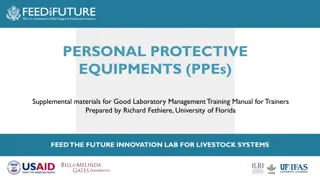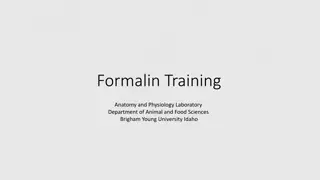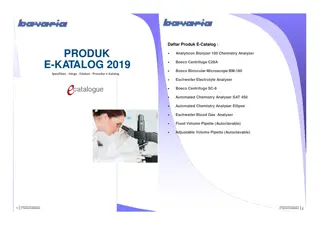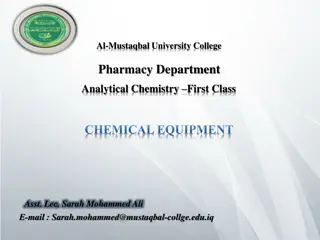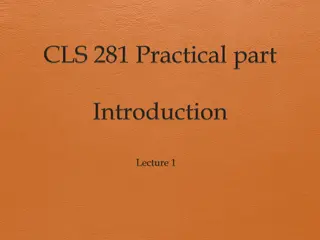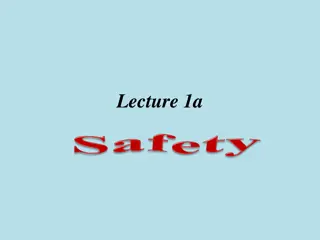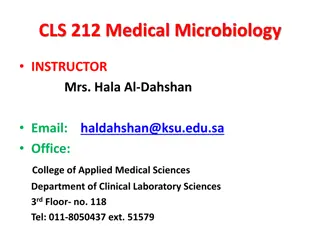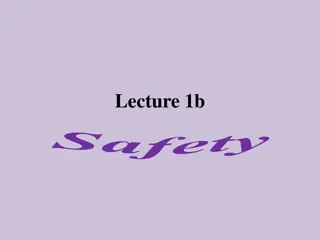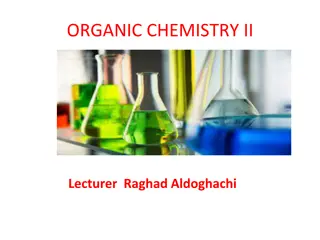Laboratory Safety and Guidelines in Medical Chemistry
The aim of the Medical Chemistry Laboratory is to provide students with practical observations, skills, and techniques related to substances and their reactions discussed in lectures and textbooks. Essential safety rules are outlined to ensure a secure working environment, emphasizing proper handling of chemicals, equipment, and personal protective measures. Detailed instructions on conducting experiments, maintaining cleanliness, and reporting observations are highlighted to enhance learning outcomes in the laboratory setting.
Download Presentation

Please find below an Image/Link to download the presentation.
The content on the website is provided AS IS for your information and personal use only. It may not be sold, licensed, or shared on other websites without obtaining consent from the author. Download presentation by click this link. If you encounter any issues during the download, it is possible that the publisher has removed the file from their server.
E N D
Presentation Transcript
Medical Chemistry / Aim of the Medical Chemistry Laboratory 1-To give you the chance to observe some of the substances, its reactions discussed in the lectures and textbooks. 2- To gain some skills, and techniques used, such as quantitative, and categorical analytical work. 3- To offer you training by careful and complete observation of certain phenomena, then recording your data about them. Data followed by analysis, to determine the significant value of your work, and then write your decision of what can you conclude from your data. This is shown in the report written at the end of each experiment.
SAETY RULES 1- No drinking, eating, chewing, & smoking are allowed in the lab. 2- Avoid inhaling any chemical fumes. If necessary, a substance may be smelt by wafting (fanning) its vapor gently towered your face. 3- Never point a test-tube nozzle when boiling a liquid at your neighbor, It may pump. 4- Also never transfer any reagent bottle, keep it (some containers emitting noxious fumes should be placed in the fume cupboard or Hood.). 5- Chemical contact should be washed immediately with copious amount of water, and to notify the instructor. 6- Discarding the reagent in the sink should be flushed down the drain with copious amount of the tap water, always noxious fumes evolve from residual reagents in the bottom of the drain.
SAETY RULES 6- Discarding the reagent in the sink should be flushed down the drain with copious amount of the tap water, always noxious fumes evolve from residual reagents in the bottom of the drain. 7- Avoid self-contamination, by keeping your hands away from your mouth, nose, and eyes. Always use gloves,& mask. 8- Electrical equipments, and connections shouldn't be handed with wet hands, nor should electrical equipments be used after a liquid has been spilled on it. 9- If you see any dangerous procedures taking place in the lab, please inform the instructor immediately. 10- Hands washing is mandatory on leaving laboratory.
GENERAL INSTRUCTION 1- It s the responsibility of each student, to study the experiment before his lab time, and to answer the questions of pre-lab Quiz. 2- Attendance at laboratory is compulsory for there is simply no other way to accomplish of the study program. 3- Read the label of the chemical reagent TWICE before using anything from the bottle. 4- Leave the reagent bottles at the side bench. Bring test tube by using test- tube holder, or beaker to the bench, then transfer the chemicals, and carry them to your bench. 5- Instructor provides you with pipette or dropper, besides reagent bottles are provided with their own pipettes or droppers. Don t insert your own pipette or dropper into the chemical reagent bottles. 6- Glass wears used are cleaned with brush, detergent, and water, and then rinsed thoroughly with tap water, after that with small amount of distilled water. Allow the Glass wears to dry. If you must use a piece of Glass wears while it is still wet, rinse it with the solution to be used. 7- Keep your bench, Glass wears clean, and leave the laboratory after washing your hands.
Test Tube clamp Used to handle hot tubes. Test Tube Used to mix, heat, or store substances. Graduated Cylinder Used to measure liquid volume. A very accurate tool. Graduated in mL. Pipettes, bulb, glass washing bottle Funnel Burette Beaker Used to stir, heat (if glass), and measure liquid volume in mL A stand used to support a ring clamp or test tube clamp. Test Tube Brush Used to clean test tubes. Test Tube Rack: Used to hold test tubes. 1ml Disposable Laboratory Pipettes Dropper, Plastic Transfer Pipette Erlenmeyer Flask







